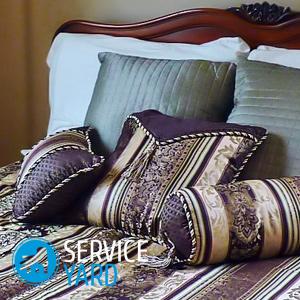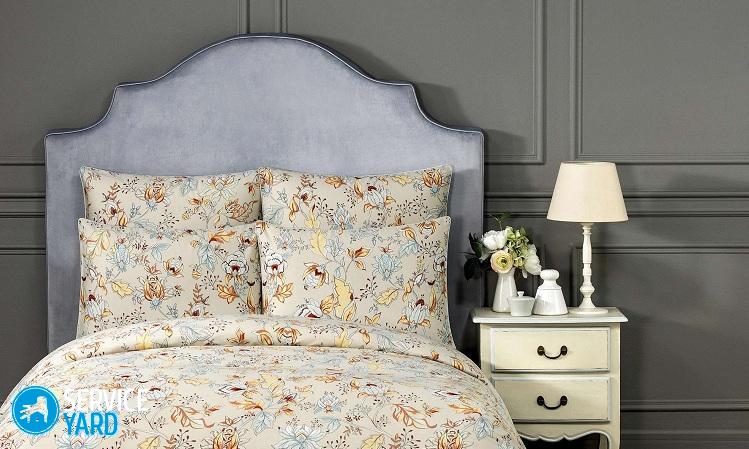The density of the fabric for bedding - which is better?

To date, the number of types of textiles for bedding is truly huge. The fact that different sellers of products from the same fiber are sold at different prices also bothers inexperienced buyers. Find out everything about the density of the fabric for bedding - which is better, what is the scope of this or that cloth. Basic knowledge in this area will allow you to determine whether a bedding set is worth the requested money.
to contents ↑The main characteristics of fabrics
The main characteristics for textiles are as follows:
- Structure.
- Type of weaving threads.
- Density (surface and linear).
- The method of dyeing fibers.
Structure
Depending on the composition of the fiber, these types of textiles are distinguished:
- Natural.
- Mixed.
- Synthetic.
Important! Natural and mixed canvases are more popular, as artificial ones have specific and not always pleasant characteristics for the user. In favor of the latter, there is only their low price.
Density
The density of the fabric for bedding is almost the main indicator that determines the quality of products. Its value is strictly regulated in various standards regarding materials. If the actual value of the indicator differs from the normative, this is nothing more than a marriage.
Linear density is determined by the number of threads per square centimeter. Depending on the density, textiles are classified as follows:
- Low - 20-30.
- Medium low - 35-40.
- Medium - 50-65.
- Medium-high - 65-80.
- High - 85-120.
- Very high - 130-280.
Important! Why do materials of the same composition have different costs? It's all about the way weave the fibers. For example, satin, ranfors and poplin are made of cotton, but the way weave is different. Hence, different properties, different costs.
In fact, there are not so many options for the fiber used in the production of bed linen:
- Linen.
- Cotton.
- Bamboo fiber.
- Silk.
- Synthetics.
Perhaps that's all. Such exotic as eucalyptus fiber, we will not take into account. And the properties are different!
Surface density
This indicator is also called grammage (the number of grams per square meter of textile). The surface density index is influenced by such factors as the adherence density of the fibers, the weaving method, and the twisting of the threads.
Now consider each type of canvas in more detail.
to contents ↑Calico
In accordance with current standards, calico is one hundred percent cotton. The thickness of the threads is quite large, the plain weave. In terms of surface density, several types of calico are distinguished. The higher it is, the better the fabric quality.
What density is better?
- 80 g / m2 - low. This is the so-called sparse calico.
- From 90 to 100 g / m2 - average.
- From 100 to 125 g / m2 - high. Such material is considered the best in quality.
- From 130 to 160 g / m2 - very high density. Textiles are used less frequently due to increased stiffness. Mostly in hospitals and railway companies.
to contents ↑Important! Coarse calico bed linen is inexpensive and practical. It is suitable for those who prefer natural materials, without emphasizing softness and elasticity.
Ranfors
This is natural cotton with a surface density of 120 g / m2. Premium cotton yarn is used for premium fabrics. When spinning the filament, the fibers fit tight enough, the fabric is beautiful and even, the surface does not pile. Ranfors is particularly strong. The linear density index is higher than that of most coarse calico fabrics. At the same time, the mass of the canvas is small.
Important! The cotton used for this fabric undergoes the process of mercerization (treatment with an alkaline solution). Mercerized cotton has a characteristic luster, is very hygroscopic, and is well dyed.
Ranfors is a soft and durable textile, used for tailoring high-quality and relatively inexpensive bedding. For many characteristics ranfors has no analogues.
to contents ↑Biomatin
One more material from one hundred percent cotton. Biomatin is distinguished by the fact that the fibers are impregnated with a hypoallergenic composition in the production. To the touch, this textile resembles a premium calico.
to contents ↑Important! The maximum density of such fabric for bedding is 120 g / m2.
Poplin
Like calico, poplin has a plain weave, only the threads are used in different thicknesses. The lobar thread is thinner and the weft thicker. In this regard, there are small scars on the surface.
The density of poplin is on average 110-120 g per square meter.
to contents ↑Important! Textiles are soft and pleasant to the touch. In this regard, it can be compared with the best grades of calico.
Satin
The front of the fabric is smooth and resembles silk. Twill weaving, double twisting of threads. Duck threads predominate on the front surface. The reverse side is soft, slightly fleecy, similar to a flannel to the touch.
The density of regular satin varies from 115 to 120 g / m2. There is also a De Luxe variety with a high density of 130 g / m2.
to contents ↑Jacquard satin
It is a cotton textile with a relief pattern. A patterned surface is obtained from a certain interweaving of threads. The cost of jacquard is quite high, it is used for tailoring bedding elite class. Jacquard is soft, hygroscopic, very pleasant to the touch, not electrified and looks very beautiful.
The density of jacquard sateen is 135-140 g / s2.
to contents ↑Important! There is also a drawback: the laundry is wrinkled, and it is not easy to iron it.
Linen
Unpainted linen cloth belongs to the category of the most environmentally friendly. Compared to cotton, flax does not need to use pesticides when grown. The color of unpainted linen is shades of ivory and grayish beige.
Flax has an antiseptic effect, does not cause allergic reactions. In the summer, the material has a cooling effect. However, linen is somewhat harsh compared to cotton. In addition, it is strongly wrinkled and poorly ironed.
Important! Blended fabric (with a ratio of flax and cotton 30 and 70%, respectively) is softer and more pleasant to the touch. Flax is a rather expensive material, mixed fabric is cheaper.
The density of linen is from 125 to 150 g / m2.
to contents ↑Bamboo
Bamboo fiber bedding has a characteristic silky sheen. Like flax, bamboo has an antiseptic effect and is hygroscopic. The cost of bamboo is high, about the same as that of a jacquard canvas.
to contents ↑Important! The disadvantage of bamboo is the choosiness in care:
- The washing temperature is 30 degrees, you can squeeze the laundry exclusively by hand.
- Erase the bamboo cloth only with colored laundry. Do not use powders with bleaches.
- Machine drying is also not for this laundry.
Tensel
This is a natural material obtained by complex processing from eucalyptus cellulose. Tensel - hypoallergenic, pleasant to the touch, silky fabric. Tensel is also distinguished by bacteriostatic properties. Such bedding is much more expensive than other types of fabrics, but whether this is justified is difficult to say.
to contents ↑Important! The disadvantage of the fabric is that it cannot be washed (the material is deformed by soaking). Only dry cleaning recommended. Store linen in a well-ventilated area, without access to direct sunlight.
findings
So, in order to purchase this or that type of bed linen, you need to answer yourself a few questions:
- What price do you think is acceptable?
- How are you going to operate the bedding?
- What are the most important tissue properties for you - softness, hypoallergenicity, ease of care?
What density of fabric for bedding is better depends on who the kit is for:
- For children and people suffering from allergies, products with low and medium density are suitable. This fabric has breathable properties, it is more delicate and soft.
- In a teenage room or for everyday use, a set of thicker fabric is suitable, which does not fade with time and is resistant to wear.
- As a wedding gift, as well as those who love luxury, durable natural fabric is perfect. You can’t call it soft, but it looks like royal bedding.
Stock footage
Now you have a full idea of what the density of the fabric for bedding affects, which is better in your case, which means that choosing the right set will not be a problem.
- How to choose a vacuum cleaner taking into account the characteristics of the house and coatings?
- What to look for when choosing a water delivery
- How to quickly create comfort at home - tips for housewives
- How to choose the perfect TV - useful tips
- What to look for when choosing blinds
- What should be running shoes?
- What useful things can you buy in a hardware store
- Iphone 11 pro max review
- Than iPhone is better than Android smartphones




